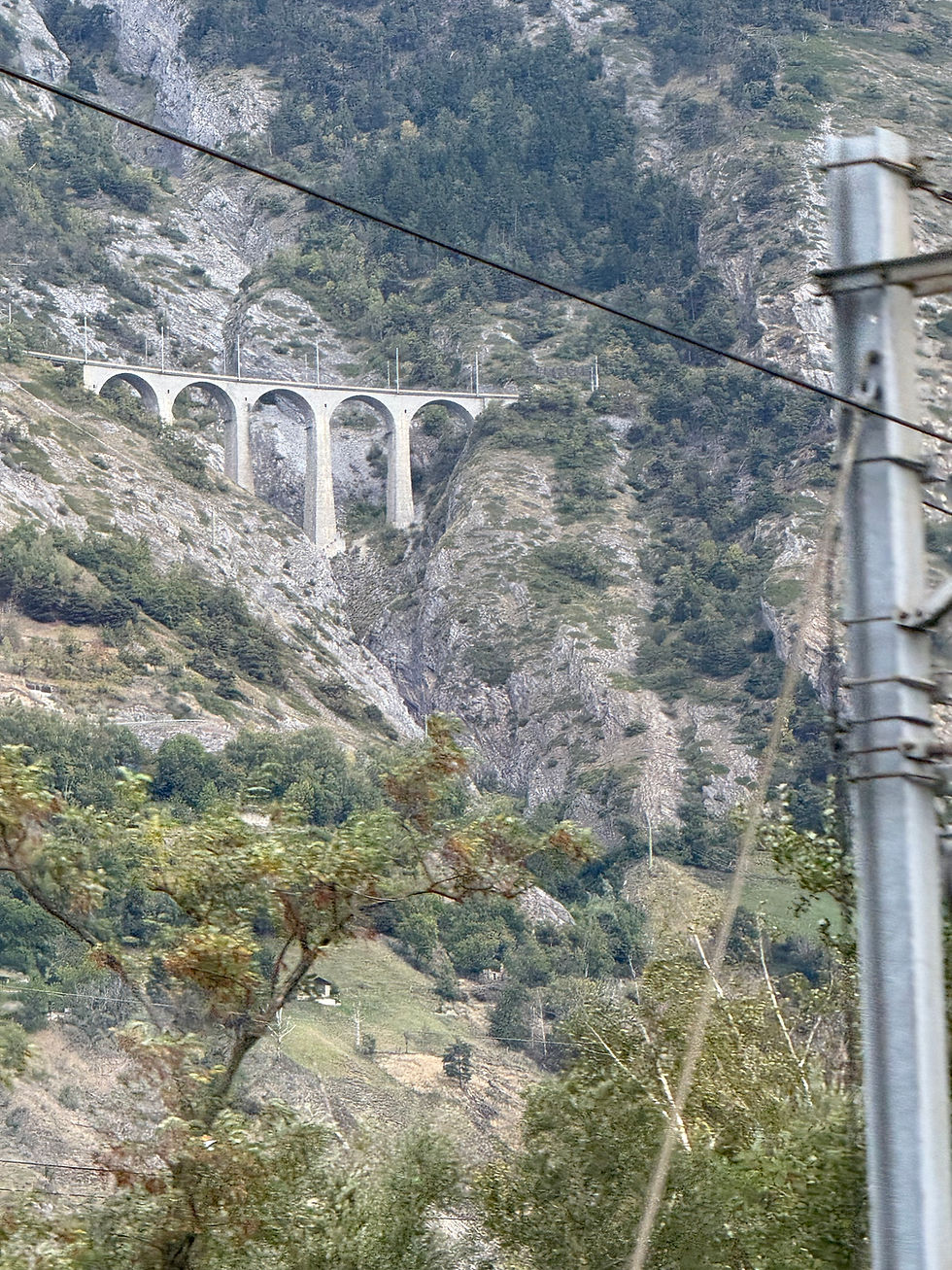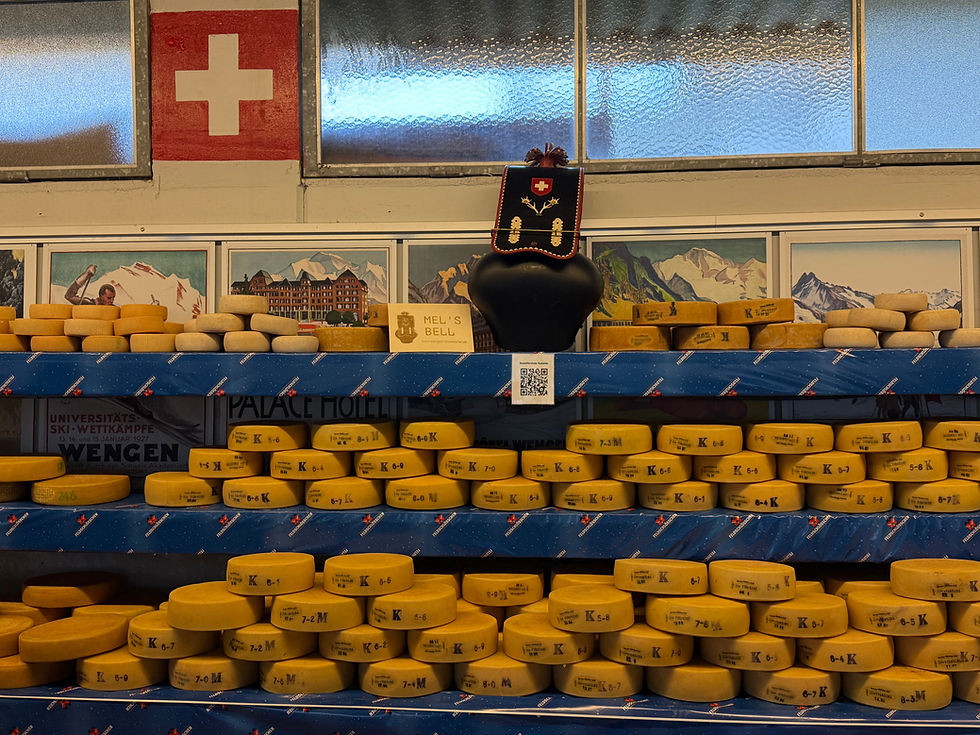Underground Lake of St. Léonard
- Deborah Kade
- Sep 24
- 6 min read
Every year I try to find a new place to visit. This year I found this underground lake of St. Léonard.
Took the train from Interlaken West to Spiez. Changed to a train going to Visp. Then in Visp, changed to a regional train stopping in St. Léonard.





When Michael and I got off the train, we just followed the signs.






Discovered in 1943 by Jean-Jacques Pittard and in operation since 1949, this is one of the most fascinating places underground, just 10 minutes from Sion.








"The “Lac Souterrain de St-Léonard” is located between Sion and Sierre, in the heart of the Valais Alps. A privileged witness to the formation of the Alps, this navigable underground lake nestles in the hillside between 30 meters (98 feet) and 70 meters (230 feet) below the vineyards. With a length of 300 meters (984 feet) and 20 meters (66 feet) wide, it is the largest natural, navigable underground lake in Europe. "





There are thirty rainbow trout in the lake. Since their is no natural food. the guides throw in food to attract the fish to the boat.









As the cave is completely submerged, all visits are made aboard rowing boats for up to 40 people.


In complete silence, the multilingual guides will take you on a tour of this fascinating world. Our guide narrated in French, German, and English. The temperature in the cave is 15 Celsius.(59 Fahrenheit). During a 30-minute guided tour, you’ll glide over the clear waters of the lake and learn to decipher its mysteries.




















"The Valais is the largest wine region and appellation in Switzerland, responsible for around one third of the country's total wine production. The main vineyard area covers the southeast-facing slopes of the dramatic Rhône River Valley as the glacial waters run southwest between Leuk (Loeche in French) and Fully.










"The river changes direction at Martigny and then runs northwest (via Chablais, in the eastern Vaud) to exit the valley and empty into Lac Léman (Lake Geneva)."
"Vineyard area here comes to around 4,800 hectares (11,800 acres) and is generally located on (often steep) slopes and terraces between the flat, fertile, heavy soils at the bottom of the valley - often given over to fruit production, industry and urban development - and the bare rock of the mountainside that towers above."
"Pinot Noir and Fendant (Chasselas) are the main varieties grown in this iconic alpine region, although it boasts well over 50 different varieties."





"The Valais terroir is one of the world's most dramatic. The valley benefits from its sheltered position below the high alpine peaks, with the most obvious bonus being the föhn wind, which keeps the area unusually warm and dry considering its altitude (most vines grow here at between 460 and 760m - 1500-2500ft)."
"A Foehn (or Föhn) wind is a strong, warm, and dry wind that blows on the leeward (sheltered) side of a mountain range, such as the Alps, Rocky Mountains, and Andes. It is caused by moist air rising and cooling on the windward side, losing its moisture through rain or snow, and then warming and drying as it descends on the leeward slope, creating a rain shadow effect."
"The foehn is a mild, dry wind that blows through the inner Alpine valleys on the northern and southern sides of the Alps. In order to determine the presence of foehn in real time, an index was developed for a number of stations in the MeteoSwiss automatic monitoring network. Most of these are located in the inner Alpine valleys, and there are also some on the Swiss plateau in the east of the country, where the foehn can blow in intense phases."
"The main prerequisite for the occurrence of foehn on the northern slopes of the Alps is a southerly wind on the main Alpine ridge, which is measured at the Gütsch station, Andermatt, (GUE). Conversely, on the southern slope of the Alps, the wind on the main Alpine ridge must come from the north for foehn to occur."
Five parameters for calculating the foehn index
"The foehn index is calculated individually for each station using different measurements. There are fixed threshold values for each parameter. These enable the index to be objectively calculated for each station, depending on where it is located and how prone it is to foehn. The parameters used (measured every ten minutes) are average speed, wind gusts, wind direction, relative humidity and potential temperature. The potential temperature is a hypothetical value that the air would have if it were measured at sea level. It is calculated from the temperature and the air pressure."
The three levels of the foehn index
"There are three levels in the foehn index. In addition to the absence (Level 0) and presence (Level 2) of foehn, there is an intermediate level at which the criteria are partially met (tending towards foehn, Level 1)."
The föhn effect is also enjoyed by Ticino, although there, mountain weather systems bring sporadic, heavy rainfall.
"Vertiginous alpine topography also gives the vines in Valais the advantage of emphasized vineyard orientation and many are planted on steep gradients of up to 90% (42 degrees). This steepness, although making it markedly harder to manage and harvest the vines, brings the significant benefits of excellent drainage and increased exposure to sunlight."
















Appellation labeling
"Production is centered around the towns and villages that run along the 50km (30 mile) section of the valley from Martigny in the southwest to Leuk, northeast. It is not unusual to see labels mention both variety and town, such as "Amignede Vétroz" or "Fendant de Sion".
T"his commune-based labeling convention is a reasonably widespread Swiss quirk as most appellations in the country follow broad, cantonal boundaries yet allow the name of the commune (sometimes even cadastral names and "lieu-dits") on the label. In the case of the Valais, a commune or local name can placed on the label so long as at least 85 percent of the grapes came from that area. The remaining 15 percent or less must come from a neighbouring zone. This convention is often confused with an appellation title."
Valais Grand Cru
"The only exception to this is the Grand Cru system which operates in a few Swiss regions, including Valais. Valais boasts 12 Grand Cru vineyard communes, or areas, each with specific grape varieties and restrictions on production (the Grand Cru title is not conferred geographically by vineyard as in Burgundy). These communes are:
Chamoson - Sylvaner (Johannisberg), Petite Arvine, Pinot Noir or Syrah
Conthey - Chasselas (Fendant), Savagnin Blanc, Pinot Noir or Cornalin
Fully - Petite Arvine, Ermitage (Marsanne), Gamay or Syrah
Leytron - Chasselas (Fendant), Humagne Blanc, Humagne Rouge or Cornalin
Saillon - Petite Arvine, Humagne Rouge, Cornalin or Syrah
Saint-Léonard - Chasselas (Fendant) or Pinot Noir
Salgesch - Salquenen - Gamay, Pinot Noir, Cornalin or Syrah
Saviese - Chasselas (Fendant), Pinot Noir or Dôle (Pinot Noir & Gamay)
Sierre - Petite Arvine, Ermitage (Marsanne), Cornalin or Syrah
Vetroz - Amigne, Chasselas (Fendant), Pinot Noir or Gamay
Ville de Sion - Chasselas (Fendant), Ermitage (Marsanne), Dôle (Pinot Noir & Gamay) or Syrah
Visperterminen - Savagnin Blanc (Heida/Paien)"
Grand Cru wines tend to be relatively rare, however.
Wine production and grape varieties
"In total, Valais produces an annual average of around 45 million liters. It is planted predominantly to Pinot Noir (just under 30 percent) and Fendant/Chasselas (17 percent). The former is sometimes blended with Gamay (over 10 percent of vineyard area) to produce the region's light red "Dôle" blend.
Historically, inferior Dôle was declassified into "Goron", whose name has historical overlap with the local Goron de Bovernier grape – still grown in minute quantities. The Goron blend remains, albeit more locally, with the proportions inverted and Gamay dominating."
"Both red blends can be complemented with other varieties also regularly seen locally and often bottled as single-varietal wines by the region's numerous small, often family-run outfits. These include the Gamay hybrids Garanoir and Gamaret, as well as the local Diolinoir, Cornalin and Humagne Rouge varieties. The latter are little-known red varieties rarely seen outside the Valais (even in the other Swiss regions they are relatively rare)."
"Indeed, the Valais is home to an array of lesser-known and obscure varieties. Amigne, often mentioned in the same breath as the commune of Vétroz, covers only 40 hectares (99 acres) worldwide, 33 of which (81 acres) are in Vétroz. Petite Arvine is also rarely seen outside of the mountainous region. Humagne Rouge is completely isolated in this ampelographer's haven.
More internationally, both Marsanne and Syrahhave climbed up the Rhône to the vineyards here, with Marsanne named Ermitage after its ancestral home, Hermitage. Pinot Gris (also called "Malvoisie" in Switzerland) and Chardonnay are also encountered."
They were picking grapes in this area today. I wish I had caught the wagon load of grapes in time and taken a picture.






Michael and I learned so many new and interesting things! It was a super day!!


Unique chair formation.






Comments